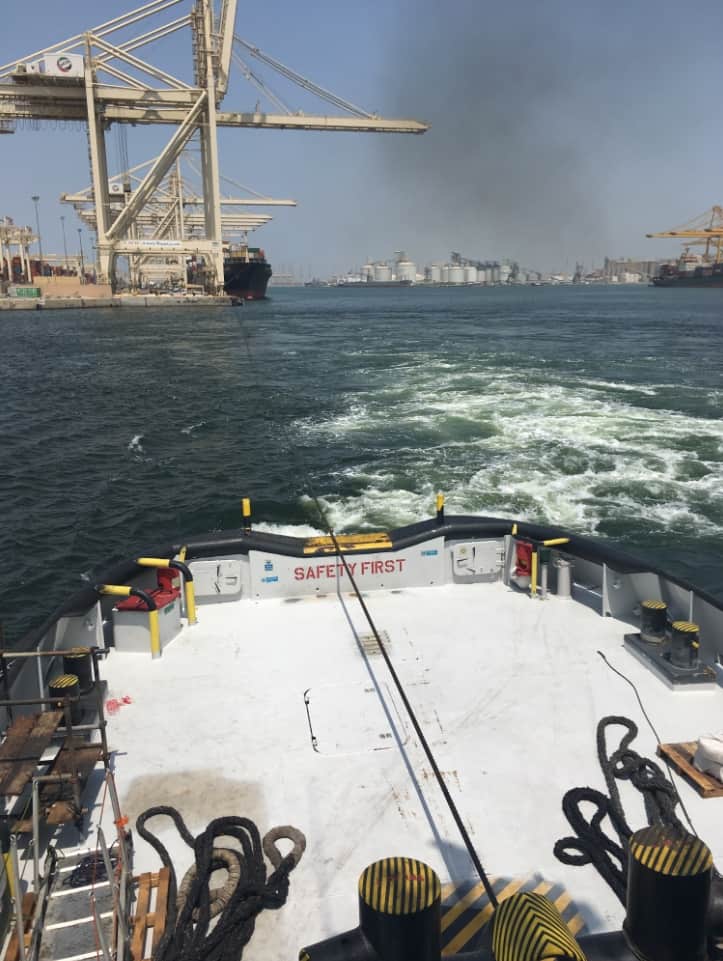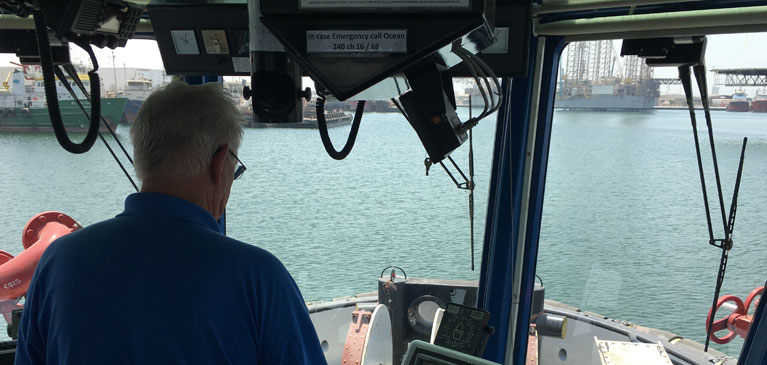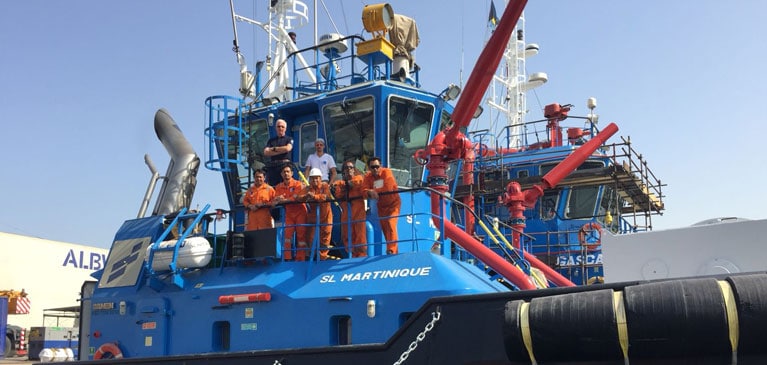´TOS calls. They offer me two ship delivery trips, so I can choose. Excellent. The first trip is from Peru via the Panama Canal to Bristol, United Kingdom. The second delivery begins in Dubai and has as its final destination Sydney, Australia. Even though I’ve never sailed the Panama Canal before, I choose for the trip Down Under.’ Captain Frans, Ship Delivery Captain at TOS shares his experiences.
ready for departure
‘I fly to Dubai and travel on to Al Hamriyah. Upon arrival we inspect the SL Martinique. The accommodations are in order, but the engine room is far from finished. Both main engines are exposed, and the starboard generator has yet to be overhauled. Plenty to do to prepare the SL Martinique for this delivery of nearly 7100 Nm and about 37 days of voyage. We get right to work. We sail to Jebel Ali for the bollard pull test. This is the test to determine the power of the tugboat and, once passed, a certificate is awarded. There is good news about the generators. Caterpillar has the generators ready. In Jebel Ali, we relocate to another berth and fill the water tanks. Everything is ready for departure the next morning at 08:00. We leave for destination Colombo without autopilot, so I steer by hand. Once we pass the Strait of Hormuz, where there is tension between the Americans and the Iranians, I set our course to sail just below the Iranian coast in the direction of Pakistan. We sail almost parallel to the Indian coast towards Colombo.’
Arrival in Colombo
‘We arrive to the roadstead of Colombo but have to wait first outside the port. There is very heavy rainfall and visibility is only 100 metres. Once the storm has passed, we enter. At 08.00 we pass directly alongside the bunker boat. At 11:30 we’re finished and head off to another berth to restock water and provisions. By 16:00 this is also completed. Despite the rain, the Chief Engineer and I go ashore. We ride through a large part of Colombo for no more than $3.00. I buy some things like tea to take home with me and at 21:00 we are back on board, soaking wet. The next morning, we leave at 8:00 headed for our next destination: Fremantle, Australia.’




Steering by hand
‘After leaving Colombo, I am still steering by hand. This was common practice early on in my career. An autopilot hadn’t been invented yet. Steering manually was done with a steering wheel and rudder. Nowadays, you only have a flimsy joystick and the rudder has been replaced by a 360-degree turning propeller: ASD Azimuth stern drive. The tugboat has two propellers, but we steer using one of these. You can imagine that steering directly with the propeller has a far greater impact than with a rudder. If you’re not paying attention for just a moment, you can get incredibly off course, which means you have to correct for this. It’s not such a problem during the day. You can tell by the horizon that the ship is turning, but at night without a horizon you only have your instruments to go by. And then you’re actually too late to make a correction. So, it often looks like the helmsman is writing his name in the wake! Fortunately, we are beginning to get the hang of steering by hand.’
‘After leaving Colombo, a hurricane between India and Africa causes high swell. The ship sways heavily. A week after departure, I receive word from TOS that the mother of a crew member has passed away. As captain, I have to pass on the message. There is intense grief, of course, but going home is unfortunately not an option. We are far from land and Fremantle still lies 10 days ahead of us. Via the satellite telephone he is able to speak with a sister. A difficult situation.’
[show_more]
Roaring Forties
‘We pass the Cocos Islands, also known as Keeling Islands and Australian territory. We are exactly halfway between Colombo and Fremantle. We don’t have much luck with the weather for this part of the voyage. The wind shifts to the south-east direction, which is the direction we’re heading, and varies between four and seven knots. I hope to get the wind behind us for the last leg of our voyage, from Fremantle to Sydney. We then head towards the region of the ROARING FORTIES, in other words, to 40 degrees south with strong westerly winds. These winds c.q. storms have free reign to circulate the expansive Southern Ocean without hitting land. This results in high swells.’
There is a story of a sailing ship long ago that needed to travel from Melbourne to Fremantle.
For weeks, the ship wrestled with the strong winds before finally deciding to turn around.
It set course to sail with the wind at its back. Passing Cape Horn, it travelled around the world Down Under to arrive in Fremantle.
‘We have a cook on board who often gets seasick. Which is no surprise on these ships. These ships like young puppies dancing and jumping around at every little body of water. Our trusty Indonesian cook does have to prepare food for a crew of eight in a galley that regularly tips 15 degrees on both sides. Imagine that in your own house, for days on end, trying to cut vegetables, preparing soup and meat, cooking and frying, baking bread, and all of that while feeling seasick. Once again, great admiration for our cook. If I was a cook, I think I would leave the sailing out of it. Although you must know that with this trip the cook earns as much as a year’s salary in Indonesia. Swaying to and fro, we approach Fremantle. We see different kinds of whales and there is a whole congregation of them in the bay just before the port. I counted at least 40 whales. The people in Fremantle explain that it is mating season. Once inside the port, we bunker and stock up on water. We also get new provisions for the last leg. And, then, we are off to Sydney, part three of the journey. We start off with good weather.
Mother Nature
‘After leaving from Fremantle, we were sailing upwind. The weather improved after Cape Leeuwin and the most south-westerly tip of Australia is looking grand. We now sail below Australia towards the Bass Strait, between Tasmania and Australia, and the weather is still good. It remains cloudy, sadly enough. Since passing Cape Leeuwin, we are seeing albatrosses again. Also, the whales are showing up. They spout water regularly, but otherwise remain below the surface. And although we are 200 miles from the coast, even some sealions are curious to get a look at the ship. Marvellous!’
‘Today I get the request to, together with the Chief Engineer, remain in Sydney to show the new crew the ropes. TOS has already booked a hotel, because our trusty cook will leave directly upon arrival. The port of destination has also changed. We are now heading for Botany Bay instead of Sydney. It’s too bad, since I would have loved to sail through the port of Sydney with the Opera House and the Sydney Harbour Bridge as a skyline. Well, Botany Bay it is. We approach the Bass Strait. Mother Nature, once again, takes us for a ride. We go full throttle on the engines, because there is bad weather up ahead with a 5-metre swell. I just hope we make it to the Australian east coast in time. And we manage!
‘Just as we enter the Bass Strait, the ship’s GPS quits on us, and I suspect it’s because of the antenna cable. Tomorrow, with proper daylight, I will send someone to the mast to investigate. The GPS connects to various equipment, such as the radar and the speedometer. The voyage is coming to its end. The final full day on the Tasmanian Sea is a special one. Never before have I seen so many different types of animals: a large ocean sunfish, sharks, whales, dolphins and many, many birds, a thriving area just off the coast.’
‘We have arrived safely! I thank the crew. The voyage together went smoothly. Sending you all warm wishes from DOWN UNDER and see you soon.’
[/show_more]
Captain Frans


YOUR DESTINATION IS OUR CHALLENGE
We are experienced in the relocation of all types of vessels. For an all-in price and with clear terms and conditions, we can take care of flag state registration, certification, ISM and instruction of the new crew in preparation of handing over the vessel.
Call now +31 10 436 62 93
Mail now Rolf Kievits, Sales Manager Ship Delivery
Read about our Ship Delivery Service
